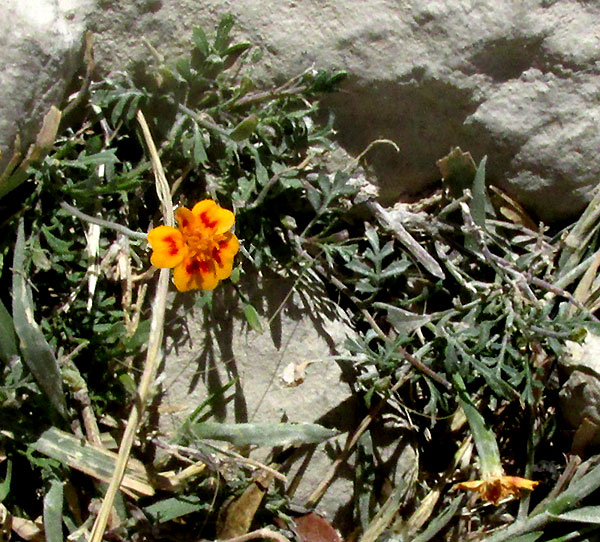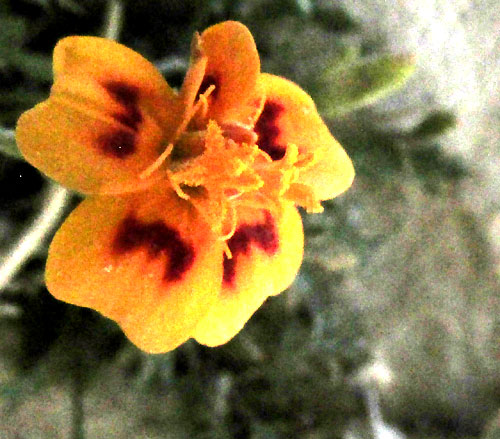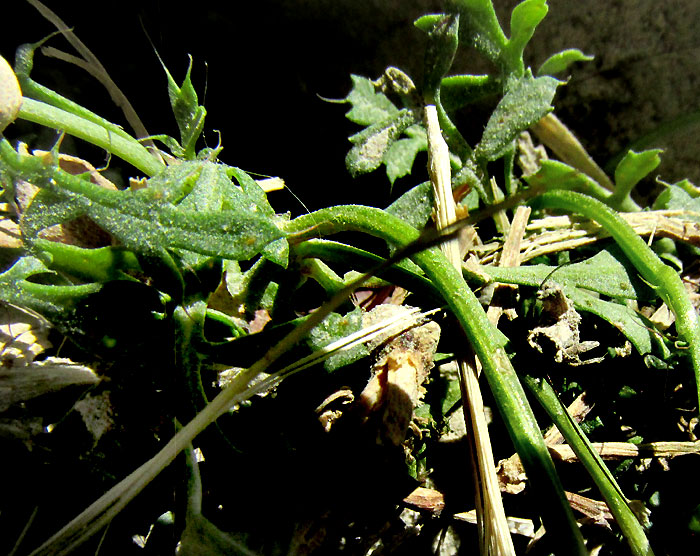Excerpts from Jim Conrad's
Naturalist Newsletter
entry from field notes dated January 17, 2023, taken on trail up the southeast-facing slope of Peña de Bernal on the northwestern side of Bernal, elevation ±2,220m (7280 ft); bedrock of intrusive, igneous dacite rock, similar to granite; Querétaro state, MÉXICO, (N20.748°, W99.949°)
RED-CRESCENT MARIGOLD

The dry season being exceptionally rainless, with the previous rainy season never quite developing, vegetation along the steep trail up Peña de Bernal's scrubby slope was crispy dry, and most leaves still hanging on tended to be limp and fading. The zigzagging, narrow footpath up the slope mostly ran atop fractured, outcropping dacite rock. In a crack of one such step-like rock, the above thumbnail-size composite blossom somehow survived, even flourished, despite each day dozens of sweating hikers climbing up to the sheer rock wall stepping over it.

The flowering head's ray florets were broad, shallowly notched at the tips, and ornamented with dark reddish-brown splotches shaped like thickly printed Ms or Ws. Disc florets in the head's center each were 5-lobed at their tops, the lobes spreading broadly.

Until now, except for the reddish-brown splotches on the ray florets' corollas, not many good field marks for identification have been noted. The above photo offers some good ones. First, the greenish, cylindrical involucre below the florets' yellow corollas is not composed of numerous overlapping, scale-like bracts, as is the case with most Composite or Aster Family species. This species' involucral bracts number only five or so, are lined up side-by-side instead of overlapping, and their mutual sides are fused together so neatly that the whole involucre looks like a smooth cylinder. Another important field mark is that the gray-green leaf at the image's lower, right corner is pinnately compound -- the blade being subdivided into several narrow sections. Moreover, each subdivision bears one or two low teeth along the margins.
At this point, the orange-yellow flowers, involucral bracts with fused margins, and pinnately compound leaves with segments bearing a few low teeth may be reminding most gardeners of marigolds, genus Tagetes. Mexico is famous for its native wild marigolds -- about 36 species found in the country -- so a good bet is that this is one of those. But more field marks are needed for sorting them out.

The above shows leaves and sprouts arising from tough, fibrous, much-abused stems. The stems aren't exactly woody, but there's a question as to whether the plant is annual or perennial. Here we seem to be seeing new sprouts issuing from last season's weathered stems. Also, here we can better see that this plant and its flowers are much smaller than cultivated marigolds.

At the plant's base, several green sprouts display soft spines on certain leaflet tips, as well as occasionally on the stems themselves.
All the above features point us to TAGETES LUNULATA, endemic just to Mexico's central uplands. Despite not occurring naturally in English-speaking countries, it bears the English name of Red-crescent Marigold, probably because sometimes it's grown by specialist collectors across the world, less for its showiness than as a marigold curiosity.
Often plants growing in such stressful environments as our crack in this much-exposed, granite-hard dacite turn out to be rare and narrowly adapted just to their specific environment. That's not the case with Tagetes lunulata, though, for this species can be found in habitats ranging from disturbed oak-pine forests to roadsides and the edges of cultivated fields, often in abundance. Our plant is just very tough and very adaptable.
In Mexico all marigold species hold a special place in people's minds because of their importance during Day of the Dead festivities. Despite their small size, Red-crescent Marigolds contribute to those celebrations as decorations of altars, woven into garlands, strewn along pathways to guide wandering spirits, etc.
Likewise, pungent-smelling marigolds in general often are used in traditional medicines. The online Atlas de las Plantas de la Medicina Tradicional Mexicana tells us that Red-crescent Marigold -- which it calls cinco llagas, or "Five Sores" -- mainly is used against diarrhea, stomach pain, indigestion and colic, as well as the cough. A hot tea of the plant is prepared and drunk. Sometimes other pungent herbs accompany the marigold in the tea, such as Chamomile, Matricaria chamomilla, and Bidens odorata.
Marigolds also often are planted around gardens to repel pests, especially nematodes in the soil. The 2018 article by M. Vázquez-Sánchez and others, entitled "Nematicidal Activity of Wild Plant Extracts against Second-Stage Juveniles of Nacobbus aberrans," reports that "As far as T. lunulata is concerned, the results are consistent with the nematicidal effects found in various Tagetes species."